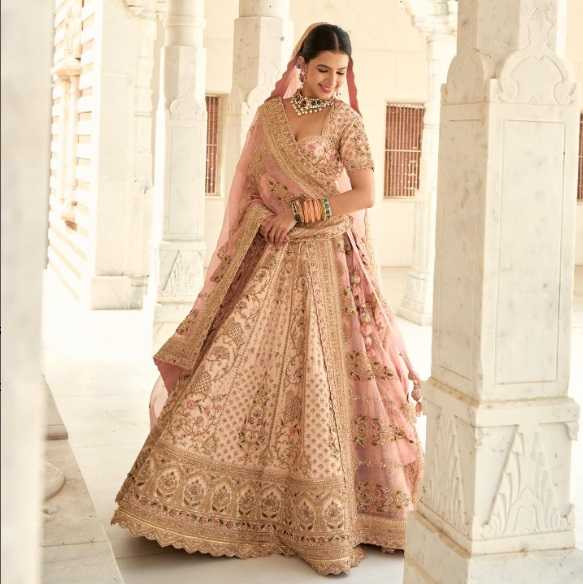Rajasthan, a land of vibrant culture and royal heritage, is not just known for its majestic palaces and forts, but also for its exquisite traditional attire known as Rajasthani poshak. The Rajasthani poshak, encompassing various styles and elements, is a testament to the state’s rich cultural heritage and its people's skilled craftsmanship. In this article, we will explore the history, components, and cultural significance of Rajasthani poshak, while also delving into its modern adaptations and global appeal.
The Essence of Rajasthani Poshak
Rajasthani poshak is a traditional attire that is deeply rooted in the history and culture of Rajasthan. It consists of several elements including the ghagra (a long skirt), choli (a blouse), odhani (a long veil or scarf), and sometimes a kurti (a tunic). Each element of the poshak is designed with intricate patterns, vibrant colors, and fine embroidery, reflecting the wearer's social status, region, and personal style.
Ghagra
The ghagra is a voluminous skirt that often features extensive embroidery, mirror work, and vibrant colors. Traditionally, it is made from fabrics like silk, cotton, and georgette, which are chosen based on the occasion and the wearer’s preferences. The ghagra is adorned with motifs inspired by nature, mythology, and everyday life, making each piece unique.
Choli
The choli is a fitted blouse that complements the ghagra. It comes in various styles, ranging from simple and elegant to heavily embellished. The choli can be short or long, with different necklines and sleeve lengths, catering to both traditional and contemporary tastes. The embroidery on the choli often matches or complements that on the ghagra, creating a harmonious ensemble.
Odhani
The odhani, also known as dupatta or chunari, is an essential part of the Rajasthani poshak. It is a long scarf that is draped over the head and shoulders, adding grace and modesty to the outfit. The odhani is typically made of lightweight fabrics like chiffon, georgette, or silk, and is embellished with intricate embroidery, zari work, and bandhani (tie-dye) patterns. The way the odhani is draped can vary based on regional traditions and personal preferences.
Kurti
In some variations of the Rajasthani poshak, a kurti is worn along with the ghagra and choli. The kurti is a tunic that adds an extra layer of elegance to the outfit. It can be short or long, plain or embroidered, and is often made from the same fabric as the ghagra or odhani.
Historical and Cultural Significance
Rajasthani poshak has a rich history that dates back to the royal era of Rajasthan. The attire was worn by women of all social strata, from queens and princesses to commoners. The elaborate designs and luxurious fabrics of the poshak signified wealth and status, especially among the royalty and nobility. Over time, the poshak evolved to reflect changing fashion trends while retaining its traditional essence.
The cultural significance of Rajasthani poshak extends beyond its aesthetic appeal. It is deeply intertwined with the state's festivals, rituals, and everyday life. During celebrations like Teej, Gangaur, and Navratri, women don the poshak in vibrant colors, adorned with traditional jewelry and accessories. The poshak also plays a crucial role in weddings, where brides wear intricately designed outfits that often become family heirlooms.
Craftsmanship and Techniques
The creation of a Rajasthani poshak involves various traditional techniques that have been passed down through generations. Skilled artisans invest countless hours into crafting each piece, ensuring that it reflects the region’s rich heritage. Some of the prominent techniques include:
Bandhani
Bandhani, or tie-dye, is a traditional technique used to create patterns on fabrics. Small sections of the fabric are tightly tied with thread before being dyed, resulting in intricate designs once the ties are removed. Bandhani is often used in odhanis and ghagras, adding a distinctive look to the poshak.
Gota Patti
Gota Patti is a form of applique work that involves sewing small pieces of gold or silver ribbon onto the fabric in intricate patterns. This technique is commonly used to embellish ghagras, cholis, and odhanis, giving the attire a regal touch.
Zari Work
Zari work involves weaving threads of gold, silver, or copper into the fabric to create elaborate patterns. This technique adds a touch of luxury to the poshak, making it suitable for special occasions and weddings.
Mirror Work
Mirror work, or shisha embroidery, is another popular technique used in Rajasthani poshak. Small mirrors are sewn onto the fabric in decorative patterns, reflecting light and adding sparkle to the attire.
Modern Adaptations and Global Appeal
While Rajasthani poshak remains rooted in tradition, it has also adapted to contemporary fashion trends. Designers are experimenting with modern cuts, fabrics, and styles, making the poshak appealing to a wider audience. Fusion outfits that combine traditional elements with modern silhouettes are gaining popularity, especially among the younger generation.
Rajasthani poshak has also gained global recognition, thanks to the efforts of designers and fashion enthusiasts who have showcased its beauty on international platforms. The intricate craftsmanship and vibrant colors of the poshak have captivated audiences worldwide, making it a popular choice for fashion shows, photo shoots, and cultural events.
The Role of Rajasthani Poshak in Festivals and Weddings
Festivals and weddings in Rajasthan are incomplete without the traditional poshak. During festivals like Teej and Gangaur, women dress in their finest poshak, complete with traditional jewelry and accessories. The vibrant colors and intricate designs of the poshak add to the festive atmosphere, creating a visual spectacle that is both enchanting and culturally significant.
Weddings in Rajasthan are grand affairs, with the bride’s attire being a highlight of the celebrations. Bridal poshak is often more elaborate, featuring heavy embroidery, gota patti work, and luxurious fabrics like silk and velvet. The bridal poshak is usually in auspicious colors like red, maroon, and gold, symbolizing prosperity and good fortune.
The Influence of Bollywood on Rajasthani Poshak
Bollywood has played a significant role in popularizing Rajasthani poshak on a global scale. Numerous films have showcased the beauty and elegance of this traditional attire, influencing fashion trends and inspiring designers. Iconic movies like "Hum Dil De Chuke Sanam," "Jodhaa Akbar," and "Padmaavat" have featured Rajasthani poshak, bringing its intricate designs and vibrant colors to the forefront of popular culture.
The influence of Bollywood has also led to an increased demand for Rajasthani poshak among fashion enthusiasts and brides-to-be. Many designers now create Bollywood-inspired Rajasthani poshak, combining traditional elements with contemporary styles to cater to the modern fashion-conscious audience.
The Future of Rajasthani Poshak
As the world becomes more interconnected, the future of Rajasthani poshak looks promising. The growing interest in sustainable and handcrafted fashion has led to a renewed appreciation for traditional attire like the poshak. Artisans and designers are finding innovative ways to preserve traditional techniques while incorporating modern elements, ensuring that the Rajasthani poshak remains relevant in the ever-evolving fashion landscape.
Efforts are also being made to promote the craftsmanship behind Rajasthani poshak, providing artisans with the recognition and support they deserve. Various government and non-government organizations are working to revive traditional crafts and empower artisans, ensuring that their skills are passed down to future generations.
Conclusion
Rajasthani poshak is more than just a traditional attire; it is a symbol of Rajasthan’s rich cultural heritage and skilled craftsmanship. From the vibrant ghagra to the intricately embroidered choli and the graceful odhani, each element of the poshak tells a story of tradition, elegance, and artistry. As it continues to evolve and adapt to modern fashion trends, the Rajasthani poshak remains a timeless piece of cultural heritage, captivating the hearts of people both in India and around the world.
Whether worn during festivals, weddings, or showcased on international platforms, Rajasthani poshak embodies the essence of Rajasthan, bringing its rich history and vibrant culture to life through the art of traditional attire. The journey of Rajasthani poshak is a testament to the enduring beauty of India’s diverse cultural tapestry, reminding us of the importance of preserving and celebrating our traditional heritage.
For more info:- leheriya sari





